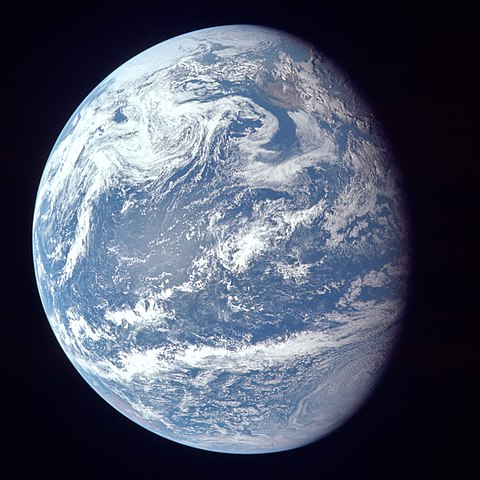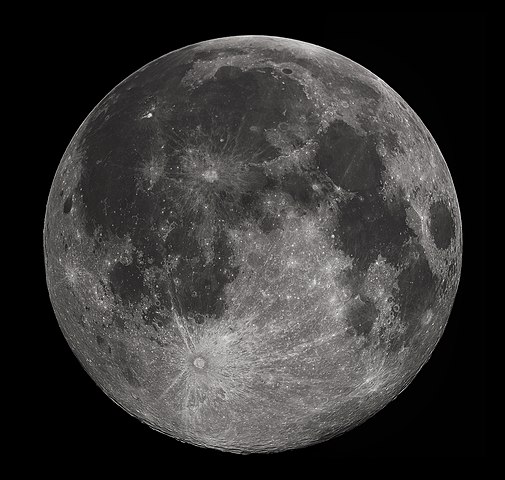Earth
Earth is the third planet from the Sun and the only astronomical object known where life developed and found habitability. This is enabled by Earth being a water world, the only one in the Solar System sustaining liquid surface water. Almost all of Earth's water is contained in its global ocean, spanning 70.8% of Earth's surface. The remaining 29.2% of Earth's surface are land, most of which is located in the form of continental landmasses within one hemisphere, Earth's land hemisphere.
Etymology
The Modern English word Earth developed, via Middle English, from an Old English noun most often spelled eorðe. It has cognates in every Germanic language, and their ancestral root has been reconstructed as *erþō. In its earliest attestation, the word eorðe was already being used to translate the many senses of Latin terra: the ground, its soil, dry land, the human world, the surface of the world (including the sea), and the globe itself. As with Roman Terra/Tellūs and Greek Gaia, Earth may have been a personified goddess in Germanic paganism: late Norse mythology included Jörð ('Earth'), a giantess often given as the mother of Thor.
Size and shape
Earth has a rounded shape, through hydrostatic equilibrium, with an average diameter of 12,742 kilometers (7,918 mi), making it the fifth largest planetary sized and largest terrestrial object of the Solar System.
Due to Earth's rotation it has the shape of an ellipsoid, bulging at its Equator, reaching 43 kilometers (27 mi) further out from its center of mass than at its poles.
Chemical composition
Earth's mass is approximately 5.97×1024 kg (5,970 Yg). It is composed mostly of iron (32.1% by mass), oxygen (30.1%), silicon (15.1%), magnesium (13.9%), sulfur (2.9%), nickel (1.8%), calcium (1.5%), and aluminum (1.4%), with the remaining 1.2% consisting of trace amounts of other elements. Due to gravitational separation, the core is primarily composed of the denser elements: iron (88.8%), with smaller amounts of nickel (5.8%), sulfur (4.5%), and less than 1% trace elements.
The most common rock constituents of the crust are oxides. Over 99% of the crust is composed of various oxides of eleven elements, principally oxides containing silicon (the silicate minerals), aluminum, iron, calcium, magnesium, potassium, or sodium.
Earth-Moon system
The Moon is a relatively large, terrestrial, planet-like natural satellite, with a diameter about one-quarter of Earth's. It is the largest moon in the Solar System relative to the size of its planet, although Charon is larger relative to the dwarf planet Pluto. The natural satellites of other planets are also referred to as "moons", after Earth's. The most widely accepted theory of the Moon's origin, the giant-impact hypothesis, states that it formed from the collision of a Mars-size protoplanet called Theia with the early Earth. This hypothesis explains the Moon's relative lack of iron and volatile elements and the fact that its composition is nearly identical to that of Earth's crust.
The gravitational attraction between Earth and the Moon causes tides on Earth. The same effect on the Moon has led to its tidal locking: its rotation period is the same as the time it takes to orbit Earth. As a result, it always presents the same face to the planet.
Artificial satellites
As of September 2021, there are 4,550 operational, human-made satellites orbiting Earth. There are also inoperative satellites, including Vanguard 1, the oldest satellite currently in orbit, and over 16,000 pieces of tracked space debris. Earth's largest artificial satellite is the International Space Station.
Earth in human culture
Human cultures have developed many views of the planet. The standard astronomical symbols of Earth are a quartered circle, 🜨, representing the four corners of the world, and a globus cruciger, ♁. Earth is sometimes personified as a deity. In many cultures it is a mother goddess that is also the primary fertility deity. Creation myths in many religions involve the creation of Earth by a supernatural deity or deities.
Scientific investigation has resulted in several culturally transformative shifts in people's view of the planet. Initial belief in a flat Earth was gradually displaced in Ancient Greece by the idea of a spherical Earth, which was attributed to both the philosophers Pythagoras and Parmenides. Earth was generally believed to be the center of the universe until the 16th century, when scientists first concluded that it was a moving object, one of the planets of the Solar System.
It was only during the 19th century that geologists realized Earth's age was at least many millions of years. Lord Kelvin used thermodynamics to estimate the age of Earth to be between 20 million and 400 million years in 1864, sparking a vigorous debate on the subject; it was only when radioactivity and radioactive dating were discovered in the late 19th and early 20th centuries that a reliable mechanism for determining Earth's age was established, proving the planet to be billions of years old.
Religious beliefs
Earth has often been personified as a deity, in particular a goddess. In many cultures the mother goddess is also portrayed as a fertility deity. To the Aztecs, Earth was called Tonantzin—"our mother"; to the Incas, Earth was called Pachamama—"mother earth". The Chinese Earth goddess Hou Tu is similar to Gaia, the Greek goddess personifying the Earth. Bhuma Devi is the goddess of Earth in Hinduism, influenced by Graha. The Tuluva people of Tulunadu in Southern India celebrate a Three Day "Earth Day" called Keddaso. This festival comes in usually on the 10th, 12th, and 13th of February every Calendar year. In Norse mythology, the Earth giantess Jörð was the mother of Thor and the daughter of Annar.
Ancient Egyptian mythology is different from that of other cultures because Earth (Geb) is male and the sky (Nut) is female.
Creation myths in many religions recall a story involving the creation of the world by a supernatural deity or deities. A variety of religious groups, often associated with fundamentalist branches of Christianity or Islam assert that their interpretations of the accounts of creation in sacred texts are literal truth and should be considered alongside or replace conventional scientific accounts of the formation of the Earth and the origin and development of life. Such assertions are opposed by the scientific community as well as other religious groups.
Classical element
Elemental earth is one of the classical elements, in some systems being one of the four along with air, fire, and water.
In alchemy, earth was believed to be primarily dry, and secondarily cold. Beyond those classical attributes, the chemical substance salt, was associated with earth and its alchemical symbol was a downward-pointing triangle, bisected by a horizontal line.
Earth is one of the five elements that appear in most Wiccan and Pagan traditions. Wicca in particular was influenced by the Golden Dawn system of magic, and Aleister Crowley's mysticism which was in turn inspired by the Golden Dawn.


